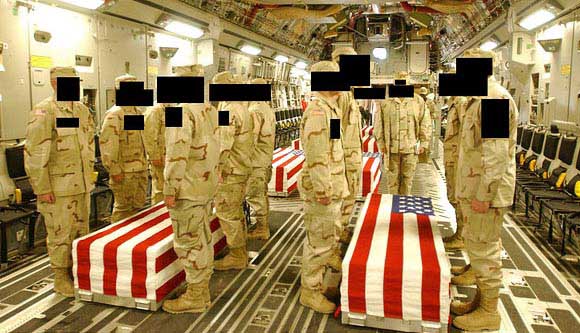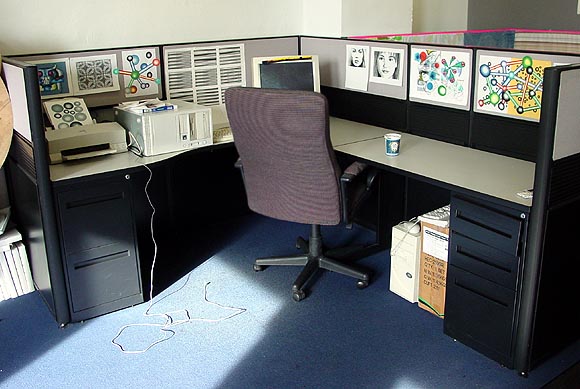View current page
...more recent posts
Good post on why a National ID card is a horrible, scary idea. The US Senate votes today: call your Senator (if it's not too late--Christ, who can keep up with all the bad legislation coming down the pike?).
The REAL ID Act requires driver's licenses to include a "common machine-readable technology." This will, of course, make identity theft easier. Assume that this information will be collected by bars and other businesses, and that it will be resold to companies like ChoicePoint and Acxiom. It actually doesn't matter how well the states and federal government protect the data on driver's licenses, as there will be parallel commercial databases with the same information.(hat tip to dratfink)
Even worse, the same specification for RFID chips embedded in passports includes details about embedding RFID chips in driver's licenses. I expect the federal government will require states to do this, with all of the associated security problems (e.g., surreptitious access).
REAL ID requires that driver's licenses contain actual addresses, and no post office boxes. There are no exceptions made for judges or police -- even undercover police officers. This seems like a major unnecessary security risk.
REAL ID also prohibits states from issuing driver's licenses to illegal aliens. This makes no sense, and will only result in these illegal aliens driving without licenses -- which isn't going to help anyone's security. (This is an interesting insecurity, and is a direct result of trying to take a document that is a specific permission to drive an automobile, and turning it into a general identification device.)
REAL ID is expensive. It's an unfunded mandate: the federal government is forcing the states to spend their own money to comply with the act. I've seen estimates that the cost to the states of complying with REAL ID will be $120 million. That's $120 million that can't be spent on actual security.
And the wackiest thing is that none of this is required. In October 2004, the Intelligence Reform and Terrorism Prevention Act of 2004 was signed into law. That law included stronger security measures for driver's licenses, the security measures recommended by the 9/11 Commission Report. That's already done. It's already law.
REAL ID goes way beyond that. It's a huge power-grab by the federal government over the states' systems for issuing driver's licenses.
REAL ID doesn't go into effect until three years after it becomes law, but I expect things to be much worse by then. One of my fears is that this new uniform driver's license will bring a new level of "show me your papers" checks by the government. Already you can't fly without an ID, even though no one has ever explained how that ID check makes airplane terrorism any harder. I have previously written about Secure Flight, another lousy security system that tries to match airline passengers against terrorist watch lists. I've already heard rumblings about requiring states to check identities against "government databases" before issuing driver's licenses. I'm sure Secure Flight will be used for cruise ships, trains, and possibly even subways. Combine REAL ID with Secure Flight and you have an unprecedented system for broad surveillance of the population.
Is there anyone who would feel safer under this kind of police state?
Film critic tedg on Ridley Scott's Kingdom of Heaven, starring Legolas (scroll down). Practically no "mainstream" critic talks about film in terms of image/editing/camera movement like this.
I've commented before about Scott's ability to have each camera shot mature at some point (about two seconds before it ends) in such a way that it anticipates the next image. No one else seems to have this ability. The famous George Stevens method was to shoot every scene from every angle and create a rhythmic dance of the eye afterward. Most filmmakers follow something like this today, which means that the registration of every shot happens after it appears, not before as with Scott.I'm getting more interested in Stevens (Shane, Penny Serenade, Giant, etc) these days and would like to follow up, through observation and the occasional comment, on this thesis of pre- and post-registration of visual information that tedg contrasts between his work and Ridley Scott's. Fascinating stuff!
Most of this, I think, is in how the camera moves. Early on, he establishes certain rules of vision that tell us when he does this, this something will follow, all done by how the camera moves. Because this visual logic is so rigidly followed, we cannot see the usual seams between real and computer generated images. He must have these rules written down for the hundreds who must be involved to understand and follow.
The story itself is mundane as with all such which have to have mass appeal. The acting is less aggressive than in his last two projects, and for my tastes that's good because it allows us more space for the cinematic experience.
Some images remain in my mind after a few days. when Saladin begins his attack on Jerusalem at night and the fireballs start coming at us over the horizon. This is truly impressive and serves as the template for the entire battle.
In that same timeframe, we have a shot of our hero anticipating. It is a three-part shot. First we see a smoky moon, then the camera moves down and to the right and we see a fluttering canvas. Each of these are amazingly rich, with the smoke anticipating the waves of the canvas. It is as if all the sea and the rolling hills and the desert were compressed into those two images. Then we move on down to our hero's face. In this ten seconds, Scott makes up for all [Orlando] Bloom's weaknesses. [...]
"Go East (Additive)" [mp3 removed]
"Go East (Subtractive)" [mp3 removed]
Both tunes are the same rhythm pattern, played with different "lead" instruments. I'm pretty amazed how much the pattern changes from tune to tune, and how much variety there is within each rendering. Except for some slight virtual knob turning, I mostly just set this up, got out of the way and let the machines do their thing. The subtractive version has some "skips" that I may or may not fix.

From UnFair Witness: "The Pentagon blacked out the faces and identifying information in some photos showing honor guards for coffins lining the interiors of C-17 transports [for returning Iraq War dead]. Thomas Blanton of the National Security Archive called the edited images 'an outrage and an insult.' (Photo Credit: Defense Department Photos Via Nsarchive.org)"
Mithras, on the above photo: "Nothing more evocative of this war for me than the officially-anonymous living honoring the anonymous dead. "
j asked if I was going to do sound-related work in connection with my upcoming performance piece of sitting in an office cubicle making art for
Yesterday one of the organizers politely but nervously asked me if I still have an, um, job these days. The answer is yes! Where I work now isn't so physically different from this "art project" and my past jobs; it is more demanding, though. We could talk about it, but let's just say blogging about my perma (as opposed to permatemp) gigs is not part of my long-term survival plan as an artist. (But

My cubicle for the ART*%@((WORK show described below. The moire pattern on the chair isn't me being deliberately psychedelic--it's a "digital camera error."
Opening in a few days is a show I'm in called "ART)@*!WORK" (the characters vary each time it's typed), taking place in a 16th floor office suite at 8th Ave and 36th Street. Artists in this group exhibition will do installations, etc., in the cubicles of this formica-heavy unrented space. The last tenant sold mobile phones or something (still checking on that--it wasn't what I originally posted). Here's how I'm describing my piece:
Tom Moody, "Office Reality: Channeling My Art Life from 1995-2000," performance work, 2005. Moody will keep "office hours" while the exhibition is open (Tues 9-5; Sun. 12-6 from May 10 to 31), and will sit and draw on an old computer. Portraits, abstract art, and tasteless cartoon imagery will be pinned up in his cubicle as he works. All will be drawn using MSPaintbrush (precursor to Microsoft Paint); Moody's attire will be "business casual."I should have photos of my "work space" up soon. Here's a summary of the press release:
ART*!(%WORK, 520 Eighth Avenue Between 36th and 37th Street. Suite 1602; opening reception with live performance by Irene Moon May 10 2005 7-9 p.m; regular "office" hours: Tuesdays 9-5 and Sundays 12-6
May 2005, New York City—Ignivomous, a non-profit arts organization dedicated to nurturing and developing new genres, art forms and mediums presents ART!@*<>WORK, an art exhibition exploring the tension between the art of doing work and the work of doing art.
This show will take place in the cubicles of a midtown Manhattan office space. Fifteen artists will transform and exhibit projects inspired by the act of doing work and the spaces created for working. Visitors will be invited to explore and interact with the space during "office hours."
ARTISTS' WORK INCLUDES: Cat Mazza (microRevolt) recreating corporate logos with knitting, machines, and needlepoint; Sabrina Gschwandtner sewing thread and paper drawings on the machine installed in her cubicle; LoVid and Douglas Repetto producing patchwork of videos generated by an installation of work clothes and electronic office supplies; Evan Greenfield and Erika Somogyi creating a shrine to lost free time out of Sculpey clay and wax; Tony Luib transforming his cubicle into an abstract environment using office supplies; Michelle Rosenberg’s installation will create a space for daydreaming; Yoav Bergner replacing the office’s furniture with his own artisan and conceptual furniture; Elana Langer installing an audio piece compiled of field recordings taken from local office spaces; N.I.N.E launching a new addition to their urban exploration game HERE "I Hate My Work"--visitors will be invited to take part in the game throughout the show; Irene Moon presenting a 4’ tall microscope as well as photographs and a video animation from her MS thesis in entomology; Brian Alfred will show a collage entitled Cubicles with a replication of all the tools used to make the work out of paper; Tom Moody installing an old computer and drawing during visiting hours portraits using the outdated software Paintbrush; Bengala will include their personal experiences from their jobs in a mixed media installation.
Hunter at DailyKos:
There are plenty of individuals in the world -- people of deep faith, regular churchgoers, etc. -- who see no conflict between faith and science. It requires significantly less imagination, if you are of both a scientific and a religious bent, to imagine the universe being set into motion through a single, unimaginably powerful spark of existence -- a singularity of time and space that gave birth to all that followed -- than it is to imagine the earth, heavens, animals, plants, elements, galaxies, fossil records, tectonic processes, quantum effects, etc., etc., etc., each being laid out one-by-one like props on a television set, all waiting to be set into motion at once when an unseen director cries action on the two poor unknowing saps gorging themselves at the buffet table. Science, as it turns out, requires that you believe in a much more powerful and ingenious God than the God of fundamentalist Topeka, Kansas.As the aliens say in Dark City: "Let the tuning commence!"
